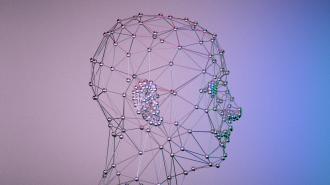People are living longer than ever, but our final years are often plagued by cognitive decline that prevents us from making the most of our longer lifespans. Science is beginning to tease out the reasons why — and what we can do about it.
Average human life expectancy has more than doubled worldwide since the start of the 20th century, rocketing from just 32 years in 1900 to 71 years in 2021. But healthy life expectancy — the number of years that people live free from disease and disability — has consistently lagged behind by almost a decade.
A host of age-related diseases can severely impact quality of life in a person’s later years. Some of the most pernicious are neurodegenerative conditions — Alzheimer’s disease, Parkinson’s disease, and various forms of dementia. Even if a person manages to reach old age without developing one of those conditions, it’s not uncommon for seniors to experience a general cognitive decline that affects their ability to live an independent and fulfilling life.
Fortunately, science is now making great strides in understanding the biological and social factors underpinning the tendency for our mental capacities to fade as we grow older. This is opening up exciting new avenues for slowing or even reversing these processes, with the ultimate goal of matching our ever-increasing lifespans to our brainspans — the amount of time during which the brain functions optimally. As Sandi Chapman, chief director of the Center for BrainHealth at the University of Texas at Dallas, put it: “What good does it do us to have these long lives if we are outlasting our brains?”
Understanding the aging brain
We know much more about how aging impacts the brain today, thanks to our rapidly improving understanding of the mechanisms that underpin aging across the entire body.
In 2013, the journal Cell published a landmark paper that identified nine “hallmarks of aging” — biological changes believed to contribute to the process. These include things like DNA damage, changes in the way genes are expressed, and dysfunction in mitochondria — the powerhouses that produce energy to fuel cellular activity.
“These are things that are happening across all tissues with age, and they’re causing problems everywhere in the body,” said Ashley Webb, an associate professor at the Buck Institute for Research on Aging in Novato, California. “But they manifest in a particular way in each tissue.”
In the brain, these processes lead to several key changes that can start to degrade the organ’s function. For example, they impair the ability of neurons to communicate with each other by disrupting synapses, the junctions that connect them. They also impact the brain’s immune cells, known as microglia, causing them to start secreting various biomolecules that trigger inflammation and further disrupt the function of neurons.
In January 2025, the journal Nature published a paper that has also helped to pinpoint genetic changes in specific cell types that drive some of the earliest stages of brain aging. Researchers at the Allen Institute for Brain Science in Seattle used a cutting-edge technique to measure changes in RNA — the biomolecule responsible for translating the genetic instructions in DNA into the proteins that are the building blocks of cells — at the single-cell level.
Crucially, the changes were occurring early in aging, long before you would expect to see symptoms of cognitive decline.
By mapping more than 1.2 million mouse brain cells across 16 brain regions, they discovered significant differences between young and middle-aged mice. In the older mice, they saw a major uptick in the activity of genes related to inflammation across the brain, as well as in those known to reduce the ability of the brain to maintain myelin sheaths. These are protective insulating layers that surround axons — the long, threadlike parts of a neuron that carry impulses away from the cell body.
These changes were particularly pronounced in a brain region known as the hypothalamus and in neurons responsible for regulating metabolism and food intake. Hongkui Zeng, director of the Allen Institute and senior author on the paper, said this suggests there may be links between brain aging and lifestyle factors, such as diet.
Crucially, the changes the researchers uncovered were occurring early in aging, long before you would expect to see symptoms of cognitive decline. That makes them promising targets for early interventions that could help slow age-related deterioration. “We think those three things actually may be triggering more downstream effects,” said Zeng. “So they themselves are the causes of many further changes happening in the brain.”
All of these age-related changes in the brain can impact its function by themselves. But they also appear to contribute to the emergence of specific neurodegenerative diseases, including Alzheimer’s and Parkinson’s. Exactly how the changes kick-start these conditions remains unsettled, said Webb, but the fact they typically develop in people’s later years makes it clear that age-related processes play a major role. And that’s leading to hope that targeting brain aging could stave off some of these debilitating conditions.
Fighting Alzheimer’s with antibodies
While there is growing interest in more general therapies to slow cognitive decline, researchers have understandably been focused on tackling the most pernicious neurodegenerative diseases. A 2025 Nature Medicine study projected that Alzheimer’s cases in the U.S. will almost double by 2060 to roughly one million a year, making it a major priority for both policymakers and drug companies.
A key characteristic of Alzheimer’s is the buildup of two types of abnormal protein clumps in the brain: amyloid plaques and tau tangles. But exactly how they contribute to the disease’s progression remains disputed, said Webb, the Buck Institute researcher. The Food and Drug Administration (FDA) recently approved two drugs designed to slow progression of the disease: lecanemab and donanemab. Both rely on antibodies that target amyloid plaques and have demonstrated modest reductions in cognitive decline. But they’ve also attracted controversy due to their high cost and potential for serious side effects.
The FDA has only approved these drugs for treating patients in the early stages of Alzheimer’s disease. But Douglas Galasko, a professor of neuroscience at the University of California, San Diego, said amyloid-targeting antibodies could also play a preventative role. The drug company Eli Lilly is now conducting a trial to see whether donanemab can slow or prevent cognitive decline in individuals who have heightened levels of amyloid but are not yet showing symptoms.
“By the time someone really shows symptoms, the brain is already damaged to a large extent.”
Li-Huei Tsai
Galasko is currently leading another clinical trial investigating whether remternetug, an experimental drug from this same class of medicines, can slow progression of Alzheimer’s in healthy people with a genetic predisposition to the disease. Galasko said his study will measure how effectively the drug removes amyloid from trial participants’ brains, but the researchers also plan to use highly sensitive cognitive tests to see if they can detect subtle changes in participants’ mental capabilities. “We think that these antibodies will certainly be able to remove the protein that builds up,” said Galasko. “The question is if that’s going to be beneficial.”
Previously, amyloid buildup could only be detected through expensive brain imaging or invasive tests that involved extracting fluid from the spinal cord. But new blood tests that can detect buildup years before symptoms appear could make preventative treatment of Alzheimer’s more practical. Because we don’t have tests that can determine who is at risk of amyloid buildup before it starts, however, there is a limit to how early preventative treatment could begin, said Galasko. Existing drugs also target factors specific to Alzheimer’s, he added, so it’s unclear whether they will have an effect on cognitive decline caused by age or other diseases.
One of Alzheimer’s first targets in the brain is the hippocampus. This region plays an important role in learning and memory by acting as the brain’s filing system, converting short-term memories into long-term ones and consolidating spatial memories. Stem cells that can generate new neurons are central to these functions, but during aging, they can become dormant and stop dividing.
This dormancy may play a role in cognitive decline and Alzheimer’s, so Webb’s lab has been investigating ways of reactivating the cells. Her startup Bolden Therapeutics is now developing an antisense oligonucleotide — a kind of biomolecule that binds to RNA to modify gene expression — designed to kick-start neurogenesis. The hope is that it could treat a range of neurological conditions and restore memory-forming capabilities lost with age and disease.
Light, sound, and memory
Genetic changes related to aging start showing up in human brains as early as age 40, something researchers at Harvard Medical School first demonstrated in a 2004 paper published in Nature. This suggests that we could be intervening much earlier, but that’ll only be possible if we can find new biomarkers for brain aging. “By the time someone really shows symptoms, the brain is already damaged to a large extent, and so the options can be very limited,” said Li-Huei Tsai, a professor of neuroscience at the Massachusetts Institute of Technology. “Even if you have something very good for intervention, it’s probably unlikely to bring you back to normal.”
One particularly promising therapeutic approach: the use of sensory stimulation to enhance gamma brain waves. Tsai’s lab is doing this by exposing people to light or sound that flickers at the same frequency as these neural oscillations, and a mounting body of evidence in both animals and humans shows the approach can reduce the accumulation of amyloid and tau proteins, prevent neuron death and synapse loss, and boost memory and cognition.
“Everybody can just get a device and treat themselves at home.”
Li-Huei Tsai
Researchers are still trying to tease out exactly how it works, but the technique seems to promote a variety of positive responses in different brain cell types, according to Tsai. In 2024, Tsai’s lab published a paper in Nature showing that gamma wave enhancement seems to boost the activity of the glymphatic system — the brain’s waste clearance mechanism — and increase the removal of amyloid plaques. The system is particularly active during sleep, Tsai noted, which could explain why poor sleep is associated with a host of age-related cognitive disorders.
Cognito Therapeutics, the startup Tsai spun out of MIT, has already completed a phase II clinical trial that showed treating Alzheimer’s patients with gamma wave enhancement significantly slowed brain atrophy and improved scores on some cognitive tests. The company is currently conducting a phase III trial.
Tsai said that one of the most exciting aspects of the approach is the fact that it is noninvasive. This could potentially enable much earlier intervention, and Tsai said her lab is currently recruiting healthy people with a family history of Alzheimer’s for a trial to see whether gamma stimulation can prevent or delay onset of the disease: “I personally think [it] will be much more accessible to people. Everybody can just get a device and treat themselves at home.”
Clearing “zombie cells”
A host of new treatment options are also coming from the emerging science of longevity medicine, which advocates for targeting the underlying processes of aging rather than specific diseases. Several drugs are currently undergoing clinical trials for their anti-aging potential, and there is tentative evidence that the immunosuppressant rapamycin and the diabetes medication metformin may be able to delay the onset of Alzheimer’s and slow cognitive decline, respectively.
Senolytics are a particularly promising class of anti-aging therapies. These drugs are designed to clear out senescent cells, which are also known as “zombie cells” because they refuse to die. They stick around and secrete biomolecules that can damage surrounding tissues. Senescent cells only really seem to cause problems when their levels exceed a certain threshold, and the body’s immune system already has processes for removing them. As people get older, though, these cells accumulate throughout the body, and scientists believe they contribute to age-related diseases.
Improper use of these drugs could carry considerable risks.
One of the most interesting aspects of senolytics is that you may not need to directly target the brain to see a benefit there, said James Kirkland, director of the Center for Advanced Gerotherapeutics at Cedars-Sinai Medical Center in Los Angeles. Animal studies suggest that using senolytics in one area of the body can often lead to reductions in levels of senescent cells in other tissues as well. One possible reason: The treatment reduces overall levels to the point that the immune system can clear out the senescent cells that remain.
One takeaway: Senolytics could be particularly useful for treating the brain, which is protected by the blood-brain barrier, a membrane that many drugs are unable to traverse. Senolytic therapies have shown promising results in mice genetically modified to exhibit some of the features of Alzheimer’s. Several human clinical trials are underway to test their potential for treating various neurological conditions, including Alzheimer’s and multiple sclerosis.
But Kirkland cautions that senolytics are a long way from being used as a preventive therapy. Senescence plays a crucial role in defending against cancer and remodeling organs in response to physiological changes, so improper use of these drugs could carry considerable risks. And we don’t yet have good biomarkers to detect when levels of senescent cells have crossed the threshold of usefulness for therapy. Because of this, Kirkland strongly discourages taking senolytics until rigorous clinical trials take place: “We don’t know if they work. We don’t know if they’re safe.”
A shot of young blood
Targeting the underlying process of aging rather than specific diseases seems like a powerful way to slow cognitive decline and neurodegenerative diseases, said Saul Villeda, an associate professor of biomedical science at the University of California, San Francisco. “Aging, to me, is what’s causing the vulnerability,” he said. “Even people with genetic predispositions, the vast majority of them, even if they have those mutations, they’re not going to get the disease until later in life.”
In 2014, Villeda and his colleagues demonstrated that transfusing blood from young mice into older ones could reverse molecular and structural changes in the brain associated with aging and boost memory and learning ability. The discovery, and subsequent studies backing up the findings, has led to a proliferation of clinics offering transfusions of blood plasma collected from young people for supposed health benefits.
“You’re hitting two major drivers of functional decline.”
Saul Villeda
Last year, the FDA issued a warning to patients that there is no evidence to back these claims and that plasma transfusion carries significant risks. Even if there were some benefit, we have no idea what kind of dosage or frequency would make sense, said Villeda. There isn’t enough plasma in blood banks for this to be a viable treatment for large numbers of people, either, which is why Villeda’s lab is now working to determine the blood components responsible for the remarkable effect.
In a 2023 Nature paper, his lab showed that certain proteins — ones involved in blood clotting and that occur in elevated levels in the blood of younger animals — could improve learning and memory when transfused into aging mice. The study also showed that the proteins primarily worked by reducing inflammation outside the brain, which then led to a reduction in inflammation inside it.
Currently, Villeda is focused on identifying blood components responsible for the beneficial health effects of exercise, low-calorie diets, and cold shock therapy, among other things. His lab has shown that transferring blood from a mouse that has exercised into a “couch potato” mouse can transfer many of the benefits of physical activity, too.
His group and others are now actively testing some of the molecules they’ve discovered in animal models of age-related diseases. And it appears that many are able to treat the disease and slow more general aging processes simultaneously. “That’s great,” said Villeda. “You’re hitting two major drivers of functional decline.”
A brain-healthy lifestyle
While young blood transfusions, zombie (cell) killers, and flickering lights all show promise in helping extend our brainspans, the most effective way we know to slow brain aging is much simpler: the time-tested combination of diet and exercise.
There is a large body of evidence showing beneficial impacts on both general and brain-specific aging from exercising, reducing calorie intake, and practicing intermittent fasting, where people go extended periods without eating. We still don’t know why these approaches work, but according to Mark Mattson, an adjunct professor of neuroscience at the Johns Hopkins University School of Medicine, growing evidence suggests that periodically exposing the body to mild stress, either in the form of food restriction or increased activity, activates genes that protect cells against more severe stress.
“This all makes sense when you think about it from an evolutionary perspective,” said Mattson. “Our bodies and brains are evolved to function well in a food-deprived state where the individual has to expend physical effort to get food.”
Exercise helps combat the hallmarks of aging by boosting muscle cells’ ability to remove “free radicals” (reactive molecules that cause damage), increasing the number of mitochondria, and even enhancing the cell’s waste disposal system, said Mattson. Exercise and fasting also boost the production of brain-derived neurotrophic factor (BDNF) molecules, which play a crucial role in learning and memory and that have antidepressant and anti-anxiety effects.
“Our bodies and brains are evolved to function well in a food-deprived state.”
Mark Mattson
Gaining a better understanding of how these lifestyle changes affect brain health could also lead to potential therapies to delay cognitive decline. A chemical that induces mitochondrial stress, 2,4-Dinitrophenol, is currently undergoing clinical trials as a potential Parkinson’s treatment, and there are efforts to develop treatments that mimic the benefits of intermittent fasting.
During fasting, the body enters a state known as ketosis, where it shifts from burning carbohydrates to burning fat-derived molecules called ketones. In 2013, Mattson contributed to a study that found that feeding mouse models of Alzheimer’s a ketone-based diet could boost memory and lessen anxiety. Multiple clinical trials are now exploring whether the approach could help older people with mild cognitive impairment or Alzheimer’s.
And yet Mattson is wary of efforts to find therapies that mimic the effects of lifestyle and diet changes. Many come with side effects, and it’s unclear so far what their long-term impact will be. More crucially, the impact of exercise and diet changes are broad-based, and these more directed therapies are unlikely to provide people with the full range of benefits. “Their long-term outcome is not going to be the same as if they did exercise regularly,” he said.
It may not, however, always be realistic to get people to adopt these lifestyle changes, said Villeda. Research has consistently demonstrated that getting people to change their behavior can be incredibly difficult. In the context of brain health, many of those requiring treatment are unable to make drastic changes to their diet or engage in strenuous exercise. “The people that we know most benefit are usually frail,” said Villeda. “Imagine something like caloric restriction. When you’re already frail, you’ve already lost weight, you actually need more calories.”
A no-brainer
The way you use your brain can also have an enormous impact on your long-term cognitive health. Chapman, the neuroscience professor at UT Dallas, has developed a cognitive training program designed to boost a host of high-level cognitive skills, such as thinking strategically, synthesizing information, and resisting distractions. In a large-scale longitudinal study, 80% of healthy adults who took part in this training showed significant gains in cognitive function in just three months, regardless of age. Brain imaging studies revealed that the training actually caused physical changes to the brain, with blood flow improving by 8% to 12% on average.
Beyond undertaking specific cognitive training, Chapman said some of the best things people can do for their long-term brain health are to keep learning new skills and making new connections with others. Just as important, she said, is avoiding toxic habits, such as multitasking and the overuse of technology. It’s hard to change the way people think about brain health, though. When it comes to cardiovascular disease, people don’t wait to have a heart attack to start medication or change their lifestyle, said Chapman, but with cognitive decline, they aren’t concerned until problems appear, and by then, it’s hard to make an impact.
Still, Chapman said there are plenty of simple things people can do to maintain their cognitive health much later into life. “It is through our brains that we experience and enjoy our lives,” she said. So doing what we can to keep them healthy should be, well, a no-brainer.
We’d love to hear from you! If you have a comment about this article or if you have a tip for a future Freethink story, please email us at [email protected].




















